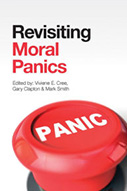Revisiting Moral Panics

Editors: Viviene E. Cree, Gary Clapton, and Mark Smith
Publisher: Bristol, UK: Policy Press (distributed in the U.S. by University of Chicago Press), 2016. 276p.
Reviewer: Emily Setty | May 2017
Moral panic as a sociological concept has been subject to critique and refinement over the decades since its inception. As the editors note, its adoption, and perhaps overuse, in popular parlance has, some suggest, somewhat diminished its academic rigour and practical relevance. Essentially, the term is invoked, sometimes lazily, to refer to a range of social phenomena and public reaction, with little consideration of the nature or applicability of the tenets of the concepts, and perhaps as a way of discounting or delegitimising particular social anxieties or perspectives. Resultantly, this book represents a timely and valuable contribution to the field. It re-articulates and critically engages with the theorised underlying dynamics of moral panic and how such dynamics are relevant to understanding contemporary social problems, including those less commonly viewed through a moral panic lens, such as food scandals and healthcare. The editors and contributors emphasise that the purpose of exploring social problems through moral panic theory is not to downplay their importance, but to examine the processes through which phenomena are constructed and the implications of such constructions for policy and practice.
The book presents case studies spanning a range of distinct, yet overlapping, social phenomena. An impressive range of contributors, spanning academics working in fields including sociology, psychology and social policy, to social work professionals, discuss these case studies in terms of moral panic theory. An explicit aim is to connect theory with practice, particularly social work practice. The book is concerned with the relevance of moral panic to understanding social issues and anxieties with which social workers routinely engage as part of their work with, often, some of the most deprived and marginalised members of society. The book explores how moral panic can aid understanding of how social problems and groups are framed and understood, the alternative discourses that are marginalised in the narratives produced, and how narrow frames and understandings risk obscuring and distorting the nature of social problems, so resulting in ineffective or problematic policy- and decision-making that fails to address the root causes of social anxieties and the challenges, risks and harms individuals and groups may face. Resultantly, the book is ideal both for academics interested in exploring the relevance and nature of the moral panic and new ways of thinking about the concept, and, as intended, social work professionals and practitioners seeking to better understand and respond to the social problems they encounter.
The book begins by setting the context, providing a brief overview as to how moral panic has been theorised, focusing particularly on Stan Cohen’s Processual Model and Goode and Ben Yehuda’s Attributional Model. The editors themselves admit this is not an exhaustive review of moral panic theory, and the section works more as a context to the case studies that follow. The section considers the relevance of findings generated by four decades of research into moral panics regarding child abuse, drugs and alcohol, immigration, media violence and street crime. The editors consider how anxieties around these topics rest upon certain assumptions about the nature of the problem, the broader social, cultural and political context to these assumptions, and the resulting policy proposals. This brief discussion highlights the variation in the nature and specificity of the ‘folk devil’, the role of the different actors and groups in defining phenomena as problems and in generating anxiety about these problems, and the different trajectories of these processes, in which panic may shut down debate and alternative narratives, while at other times is resisted and does not create the hoped-for change.
While the editors are clearly in favour of the continuing relevance of moral panic, they acknowledge, and then refute, key criticisms of the theory as they are aware of the risks of the concept being considered irrelevant if not explored critically. In doing so, they assert their intention to position moral panic as a way of navigating and analysing reactions to complex social problems and to critically engage with the proposed solutions and implications of these reactions. As with their discussion of the theory, it is unavoidably brief, and the interested reader has plenty of avenues to pick up to explore further. Essentially, moral panic is presented as relevant, if needing to be refined and developed. The authors consider the concept in terms of a range of alternative sociological concepts, including risk, discourse, and moral regulation, as well as psychology, for example around emotion, identity and collective behaviour. Moral panic is, therefore, not considered a totalising concept, but one best understood as part of a range of concepts that can shed light on social phenomena — a ‘tool in the box’, perhaps. This way of approaching moral panic is epitomised in the case studies that follow.
The case studies are discussed in four sections covering ‘gender and the family’, ‘childhood and youth’, ‘the state, government and citizens’, and ‘moral crusades, moral regulation and morality’. Each comprises five case studies and begins with an introduction discussing a key moral panic theorist whose work and arguments are relevant to each case study. At the end of each section, a social work professional draws together the case studies and discusses the implications of the analysis and moral panic to their work, as well as the future of social work more broadly. This structure is highly readable and engaging, and underscores the academic and practical relevance and value of the book.
The diverse case studies each demonstrate the varying ways and extents to which moral panic can explain social reactions and responses. The first section on ‘gender and family’ reveals how reactions and responses can be understood in terms of broader discourses of risk, othering and stigma, and ongoing ideologically-driven policy-making. The discussion of working-class femininity is particularly insightful in conceptualising ‘spatial folk devils’, in which individuals come to embody the classed stigma of their local area. The family violence case study emphasised, however, the importance of acknowledging the multiple, diverse voices potentially present in a panic, which may limit the ability for more extreme constructions and proposals to gain widespread consensus and traction. The discussion about early intervention is particularly relevant to the contemporary context, and explores the changing nature of the family from ‘autonomous’, ‘idealised’ unit to ‘potential problem’ requiring state intervention. In the afterword, Stuart Waiton reflects upon the implications of moral panic in terms of the encroachment into family and private life, particularly in rendering all potentially ‘at-risk’ and vulnerable, and how these judgments remain grounded in other forms of stigma. As acknowledged, the section focuses more on girls and women, and considerations of how fathers react to the stigma of being a teen parent or the role of working-class masculinity in family violence, for example, would have been additionally insightful.
The second section on ‘childhood and youth’ explores child protection, child trafficking, ‘lost’ childhood, internet risk and sexual abuse, and the Rotherham abuse scandal. A strength of this section is in showing how framing and construction of social phenomena, particularly those involving the emotive topic of harm and risk to children, can obscure the nature of the problem and promote policy responses that do not get to the root of issues or acknowledge broader social, cultural and economic contexts. The case studies show how social problems can be presented as ‘symbols’ of social and moral decay, and used to further broader political and ideological agendas. While panics may appear new, this section shows how constructions and responses to phenomena involving children and childhood actually reflect and reproduce long-standing anxieties and concerns, even when they draw in seemingly recent change, such as around technology. In the afterword, Gary Clapton discusses the implications of the case studies, particularly in terms of the importance of connecting events to broader contexts, and avoiding the reductionism and stereotyping that can feature in reactions to social problems.
The case studies in the third section on ‘the state, government and citizens’ cover children and internet pornography, internet radicalisation, the social reaction to ‘chavs’, troubled families and the England ‘riots’, and patient safety. The case studies show how reactions can be used to promote repressive and regressive state intervention and regulation, such as around internet censorship, surveillance of ‘suspect’ or ‘problem’ populations, and individualisation and stigmatisation of economic deprivation and marginalisation. The patient safety case study was particularly intriguing, showing how even phenomena that lack identifiable folk devils may still be understood in terms of moral panic with respect to how moral entrepreneurs seek to establish control over narratives to effect institutional change. In the afterword, Neil Hume considers how involvement of social services under moral panic conditions can imply that individuals are threats to law and order, with implications for engagement with and labelling of particular populations. He argues that social anxieties are ‘real’ but need to be meaningfully addressed to avoid becoming panics. He considers social workers key players in deconstructing dominant discourses, by dismantling myths and stereotypes, and promoting social cohesion.
The final section on ‘moral crusades, moral regulation and morality’ covers paedophilia, religious animal slaughter, sham marriages, Roma communities, and assisted dying. The case studies reveal how moralising discourses can restrict discussion, demarcate ‘good’ and ‘evil’, ‘deserving’ and ‘undeserving’, and caricature individuals and communities. The section shows how such discourses reveal ignorance and a projection of immorality to the ‘other’, as seen in the panic around religious animal slaughter. The case studies show how these processes can be as much, if not more so, about stigma and exclusion of ‘undesirable’ populations, who are rendered threats to the morality and integrity of the ‘majority’. The discussion of sham marriages shows panic can be linked to longer-standing concerns, such as around immigration and border control, so justifying control, regulation and surveillance. The inclusion of assisted dying was more an example of how moral panic may provide a framework through which to understand phenomena, but may as much reveal that a diversity of compelling and irreconcilable perspectives can dampen the potential for panic and promote more measured, ongoing debate, underscoring the importance of avoiding the marginalisation of alternative discourses. In the afterword, Heather Lynch reflects upon how panics are, effectively, neutral and that it is how they are steered that matters. She discusses the Scottish Government’s approach to tackling violence against girls and women to explore how polarisation of victims and predators can essentialise gender and obscure the multifariousness and complexity of harm and vulnerability. She suggests panics can create change, which is not inherently right or wrong but dependent upon the type of change that is promoted. She argues that prioritising collective responsibility over blame is essential.
Overall, the sections underscore the value of using moral panic to explore social phenomena. The book places social problems within a broader context and shows the varying ways social anxieties can be understood. In drawing together the case studies, the editors discuss how a combination of fear of social breakdown, the unknown and the ‘other’ can underpin anxieties and panics, which need to be responded to ‘ethically’. Such tendencies and fears in society mean moral panic is likely to be of continuing relevance, at least as a guide to understanding the different elements of a given social problem. The case studies show how moral panic can be used to explore how panics may, or may not, gain momentum. Resultantly, it is presented as not the only lens through which to view social problems but a useful starting point to break down the different elements and to critically understand the nature and implications of the responses that follow — which may be repressive and illiberal. This readable, engaging book updates moral panic and shows its continuing relevance alongside a range of interrelated concepts and approaches. The book would be of most value to those seeking to explore how moral panic may be relevant to key social issues of the day, and those looking for an accessible guide to how moral panic would support either their academic or practical approach to understanding and addressing complex social problems and anxieties.
Emily Setty, PhD Researcher, University of Surrey


